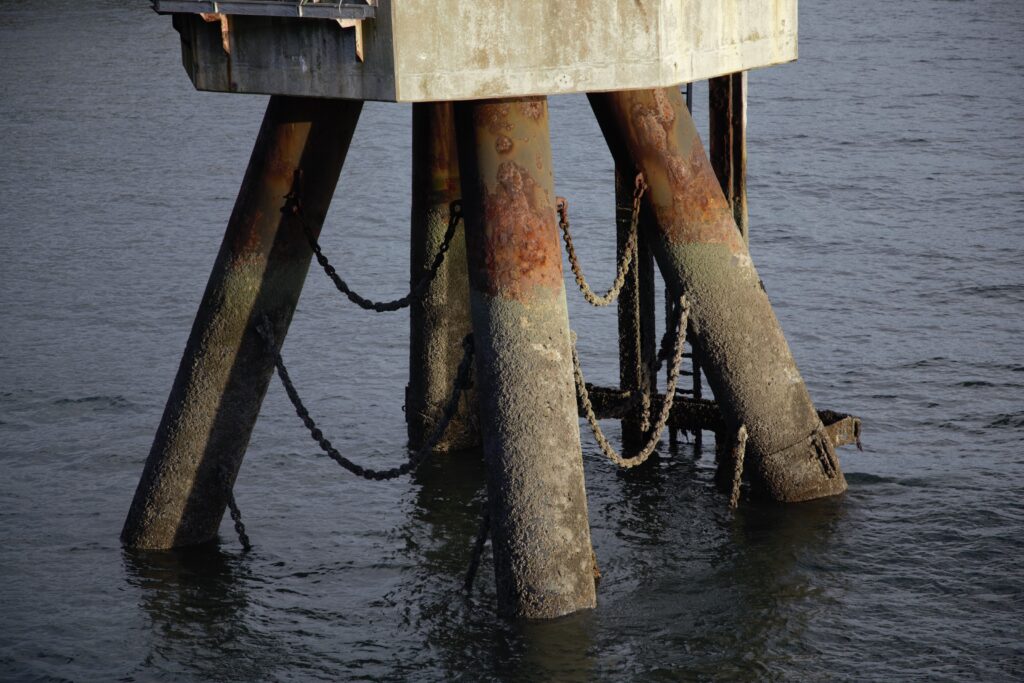
Protecting assets –
Tackling marine growth head-on
In the splashzone, the area between the topside and subsea elements of an offshore structure, there is an added element of difficulty when it comes to managing cleaning and maintenance activity. Marine growth accumulation is a significant challenge and can lead to increased weight, drag, and corrosion. In this blog, we will discuss the conditions to consider and the effect it can have on our clients’ offshore infrastructure.

AquaTerra’s Martin Longmuir NDT Manager recently discussed this topic in further detail within a recent blog we shared in April.
The ideal conditions for marine growth
Marine growth on subsea structures can be affected by a variety of factors, including:
- Water Temperature
- Light Availability
- Nutrient Availability
- Water Flow
- Substrate Type
- Environmental Conditions
Surrounded by oxygenated, warmer surface water, and plenty of daylight, many of these conditions are especially favourable for build-up in the splashzone.
Understanding these factors can help in predicting and managing the growth of marine organisms on subsea structures.

Examining the problem
The combination of marine growth and wave loading on offshore structures can increase the probability of tubular defects and failure. This can be driven by a combination of a number of underlying factors:
- Increased weight: Accumulation can significantly increase the weight of offshore structures, leading to a higher load on the foundations. This can compromise the stability of the structure and increase the risk of structural damage or failure.
- Increased drag: The accumulation on the surface of offshore structures can also increase the drag on the structure, which can affect its performance. This is particularly significant for offshore wind turbines, where increased drag can reduce energy production.
- Corrosion: Marine growth can accelerate the corrosion process on offshore structures. This is because the accumulation of marine organisms can trap seawater and other corrosive agents, leading to localised corrosion.



The weight of marine growth on a tubular structure is subject to various factors, such as its geographical position, water temperature, type of organism, and duration of exposure to the surroundings. On average, the weight of marine growth is around 10-15kg per metre. Consequently, in a location like the splash zone, the growth could reach a height of 5 meters, adding an extra weight of 50-75kg to the tubular structure.
Marine growth typically exhibits a moderate to high drag coefficient, ranging from 0.2 to 0.5. As a result, it exerts additional loads on the tubular structure, which can cause wear, stress, and other forms of damage.
Looking for better solutions
Regular cleaning and maintenance of offshore structures is essential to prevent accumulation, however, modern offshore assets are under increasing pressure from regulators and environmental interest groups to undertake these activities in a safer, more environmentally responsible way.
Traditional methods of removal can involve harsh chemicals or labour-intensive techniques. However, there are safer, simpler, and more cost-effective ways emerging to remove marine growth without the use of chemicals or exposing personnel to the challenging splashzone environment.
AquaTerra’s approach to marine growth in the splashzone
Driven by our commitment to innovation and providing the best solutions for our clients, we have developed a complete range of specialist products and procedures to enable efficient, productive and safe underdeck and Splashzone inspection, repair and maintenance.
Our dedicated Splashzone technologies, such as MGP-i, provide solutions that innovatively mitigate these challenges. These innovations offer rapid, low-cost, long-term methods to tackle marine growth, while reducing or removing the need for ROV or diver intervention.
Read more about our splashzone removal technologies on our products pages, or visit the product pages for MGP-i and AquaCLAM here.

Learn more about our ongoing work in the splashzone by following us on LinkedIn and Facebook.
